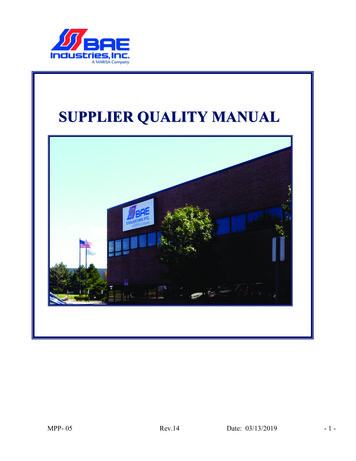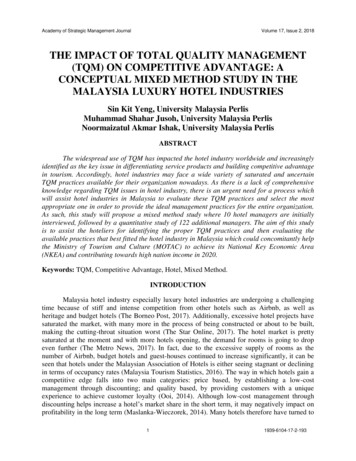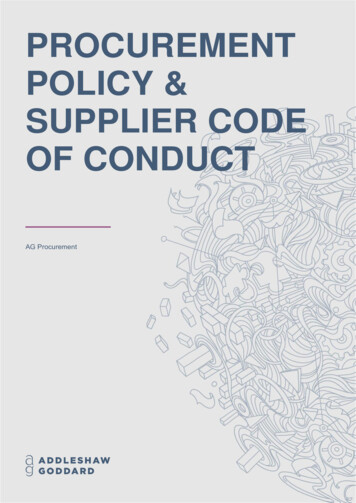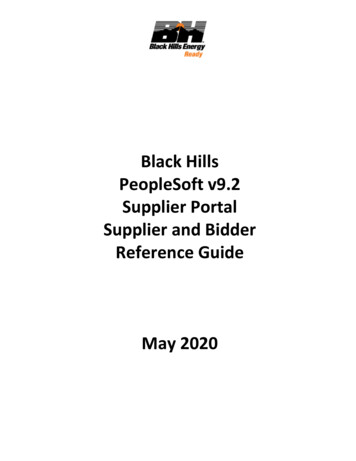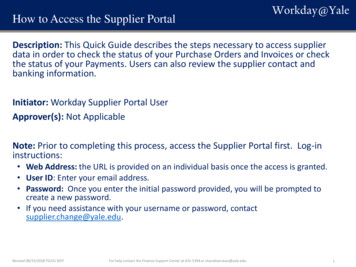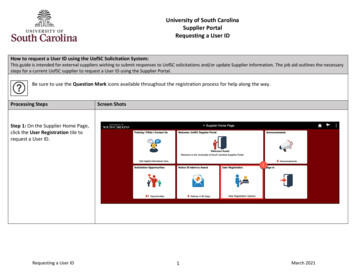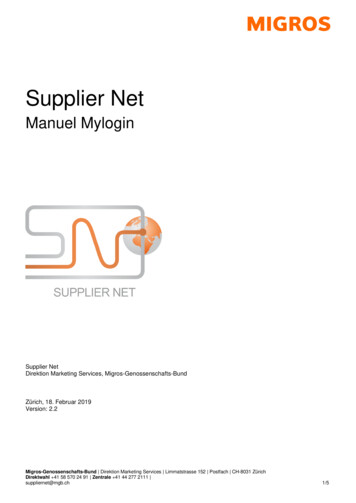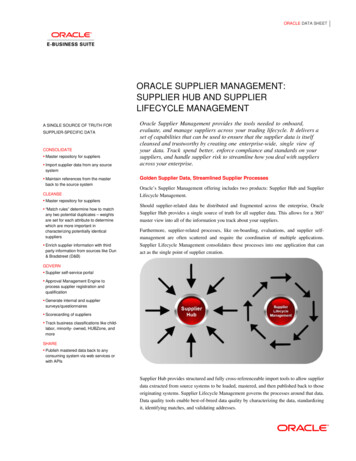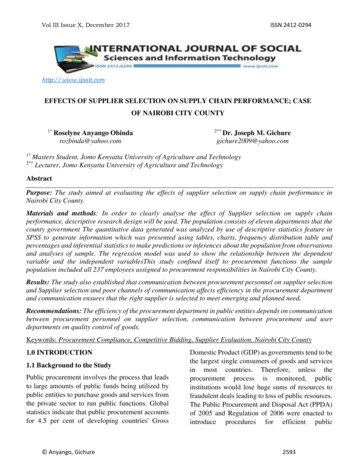
Transcription
Vol III Issue X, December 2017ISSN 2412-0294http://www.ijssit.comEFFECTS OF SUPPLIER SELECTION ON SUPPLY CHAIN PERFORMANCE; CASEOF NAIROBI CITY COUNTY1*1*Roselyne Anyango Obindarozbinda@yahoo.com2**Dr. Joseph M. Gichuregichure2009@yahoo.comMasters Student, Jomo Kenyatta University of Agriculture and TechnologyLecturer, Jomo Kenyatta University of Agriculture and Technology2**AbstractPurpose: The study aimed at evaluating the effects of supplier selection on supply chain performance inNairobi City County.Materials and methods: In order to clearly analyse the effect of Supplier selection on supply chainperformance, descriptive research design will be used. The population consists of eleven departments that thecounty government The quantitative data generated was analyzed by use of descriptive statistics feature inSPSS to generate information which was presented using tables, charts, frequency distribution table andpercentages and inferential statistics to make predictions or inferences about the population from observationsand analyses of sample. The regression model was used to show the relationship between the dependentvariable and the independent variablesThis study confined itself to procurement functions the samplepopulation included all 237 employees assigned to procurement responsibilities in Nairobi City County.Results: The study also established that communication between procurement personnel on supplier selectionand Supplier selection and poor channels of communication affects efficiency in the procurement departmentand communication ensures that the right supplier is selected to meet emerging and planned need.Recommendations: The efficiency of the procurement department in public entities depends on communicationbetween procurement personnel on supplier selection, communication between procurement and userdepartments on quality control of goods.Keywords: Procurement Compliance, Competitive Bidding, Supplier Evaluation, Nairobi City County1.0 INTRODUCTION1.1 Background to the StudyPublic procurement involves the process that leadsto large amounts of public funds being utilized bypublic entities to purchase goods and services fromthe private sector to run public functions. Globalstatistics indicate that public procurement accountsfor 4.5 per cent of developing countries' Gross Anyango, GichureDomestic Product (GDP) as governments tend to bethe largest single consumers of goods and servicesin most countries. Therefore, unless theprocurement process is monitored, publicinstitutions would lose huge sums of resources tofraudulent deals leading to loss of public resources.The Public Procurement and Disposal Act (PPDA)of 2005 and Regulation of 2006 were enacted tointroduce procedures for efficient public2593
Vol III Issue X, December 2017ISSN 2412-0294procurement, promote competition, integrity andfairness of procurement procedures, enhanceSupply chain competency and Supplier selection,and restore public confidence in procurementprocess and to facilitate the promotion of localindustries and economic development (PPOA,2012). This was a result of a 2005 IndependentProcurement Review, conducted jointly by theGovernment of Kenya (GoK) and the EuropeanUnion that identified several critical problems withKenya’s procurement system. Reforms in thepublic procurement system of a nation plays a keyrole in promoting integrity, Supplier selection,efficiency and supply chain technological system inthe manner in which the procurement functions arehandled.(2013) examined the impact of the implementationof Public Procurement Act 2003 (Act 663), on thetimely delivery of goods and services using a casestudy of Ghana Water Company Limited (GWCL)and established that the Act on its own is carefullycrafted to enhance the timely delivery of goods andservices for Public Institutions. The main problemis that the human factor in the implementation doesnot complement it. Regarding the objective offinding out the exact issues which impede orotherwise aid the timely acquisition of goods andservices during implementation of the PublicProcurement Act 2003 (Act 663) by procurementpractitioners at the GWCL, it was realized that thepoor human efforts within certain stages of theimplementation of the Act was the cause.Ambe and Badenhorst Weiss (2012) acknowledgesthat implementation of Public Procurement (PP)plays a key role in the management of publicresources. Implementation of PP ensures that publicinstitutions enjoy the benefits of quality, timeliness,cost, minimized risks, maximized competition, andintegrity. Kiama (2014) notes that irregularprocurement activities in public institutions providethe biggest loophole through which publicresources are misappropriated. According toMarendi (2015), the basic principles of goodprocurement practice include Supplier selection,where effective mechanisms must be in place inorder to enable procuring entities spend the limitedresources carefully, knowing clearly that they areaccountable to members of the public; competitivesupply, which requires the procurement be carriedout by competition unless there are convincingreasons for single sourcing; and consistency, whichemphasizes the equal treatment of all biddersirrespective of race, nationality or politicalaffiliation.In another study, Philipps, Espert and Eichhorst(2011) examined sustainable public procurement(SPP) in urban administrations in China andestablished that for the successful integration ofsocial and ecological criteria in the procurementprocess and widespread implementation thereof, anadequate policy framework is of utmostimportance. Based on the practical experiencesgained in the SuPP-Urb project, potential policyapproaches for the enhancement of the national andlocal regulatory framework of SPP in urban Chinawere developed.1.1.1 Global Perspective of implementation ofpublic procurementOn the global perspective, a number of studies havereviewed challenges facing implementation ofPublic Procurement Acts. For instance, Oppong Anyango, Gichure1.1.2 Regional Perspective of implementation ofpublic procurementThe Public Procurement Law, 2003 (Act 663) is acomprehensive legislation designed to eliminate theshortcomings and organizational weaknesses whichwere inherent in public procurement in Ghana. Thegovernment of Ghana, in consultation with itsdevelopment partners had identified the publicprocurement system as an area that required urgentattention in view of the widespread perception ofcorrupt practices and inefficiencies, and to buildtrust in the procurement system. A study by theWorld Bank (2003a) reported that about 50-70% ofthe national budget (after personal emoluments) isprocurement related. Therefore, an efficient public2594
Vol III Issue X, December 2017procurement system could ensure value for moneyin government expenditure, which is essential to acountryfacingenormousdevelopmentalchallenges. To ensure sanity and value for moneyin the public procurement landscape, thegovernment of Ghana in 1996 launched the PublicFinancial Management Reform Programme(PUFMARP). The purpose of the program was toimprove financial management in Ghana.PUFMARP identified weaknesses in theprocurement system. Some of these weaknessesincluded: lack of comprehensive publicprocurement policy, lack of central body withtechnical expertise, absence of clearly defined rolesand responsibilities for procurement entities,absence of comprehensive legal regime tosafeguard public procurement, lack of rules andregulations to guide, direct, train and monitorpublic procurement. The program also identifiedthat there was no independent appeals process toaddress complaints from tenderersThese findings le to the establishment of the PublicProcurement Oversight Group in 1999. The aim ofthis group was to steer the design of acomprehensive public procurement reformprogram which led to the drafting of a publicprocurement bill in September 2002 that waspassed into law on 31 December 2003. This paperoutlines the events leading to the publicprocurement reforms in Ghana and tion of the law. Some pragmatic ways,which if adopted, could improve the effectivenessof the law and reduce the operational challenges aresuggested. Substantial evidence in literaturesuggests that procurement problems relating toGhana are similar to the situations in many Africanand some Asian countries (Aniekwu & Okpala,1988; Kumaraswamy, 1994; Rwelamila, Talukhaba& Ngowi, 1999). The challenges observed and theremedial steps suggested are therefore of widerimportance to many developing economies. Anumber of authors have investigated the factors thatmilitate against procurement reforms around the Anyango, GichureISSN 2412-0294globe (Thai, 2004; Wittig & Jeng, 2004; NPPAAnnual Report, 2005). However, these previousstudies have not reported on obstacles to theprocurement reforms in Ghana. There is thereforethe need to undertake a rigorous analysis of factorsthat have prevented the law in Ghana fromachieving the purpose for which it was enacted. Theobject of this paper is to identify the specificchallenges, in the case of Ghana, that militateagainst the smooth implementation of the PublicProcurement Law and to proffer some solutions toaddress the issues that confront the successfulimplementation of the law. Further this study aimsat promoting discussion and reflection on stepsneeded to promote procurement reforms.1.1.3 Local Perspective of implementation ofpublic procurementA number of studies have been conducted in Kenyaon implementation of public procurement. Forinstance, Apiyo and Mburu (2014) examinedfactors affecting procurement planning in countygovernments in Kenya using a case study ofNairobi City County. The findings indicate thatinadequate competencies of procurement staff, lackofmanagementsupport,InformationCommunication and Technology (ICT) tools andbudgeting procedures affect procurement planning.Finally, the study recommends a further research tobe carried out in other counties to find out if thesame results can be obtained. In another study,Mwangi and Moronge (2016) examined theinfluence of procurement practices on performanceof logistics firms in Kenya using a case of NairobiCity County and established that suppliermanagement, inventory management, and ICTaffected performance of logistic firms.Rotich, Muma and Waruguru (2015) explored therelationship between e-tendering and Supply chainperformance among county governments in Kenya.The findings indicate that e-tendering is positivelyrelated with performance of supply chain functionof County Governments in Kenya. Mbae (2014)studied public procurement law and Supply chain2595
Vol III Issue X, December 2017performance of county governments in Kenyausing case of Machakos County Government andestablished that the public procurement regulationlaw had reduced the speed with which goods andservices are procured, increased the level of Supplychain competency among Government offices,improved utilization of funds in the CountyGovernment operations, improved the capacity ofthe staff involved in procurement processes,improved the quality of projects undertaken by theCounty Government and provided room forprocurement dispute resolution at the County.Nairobi City County was founded in 2013 on thesame boundaries as Nairobi Province, after Kenya's8 provinces were subdivided into 47 counties. It isone of County governments envisioned by the 2010Constitution of Kenya as the units of devolvedgovernment. It is governed by the CountyGovernment of Nairobi, under the leadership of thegovernor. The county is composed of 17Parliamentary constituencies (NCC, 2013).1.1.4 Nairobi City CountyNairobi City County was founded in 2013 on thesame boundaries as Nairobi Province, after Kenya's8 provinces were subdivided into 47 counties. It isone of County governments envisioned by the 2010Constitution of Kenya as the units of devolvedgovernment. It is governed by the CountyGovernment of Nairobi, under the leadership of thegovernor. The county is composed of 17Parliamentary constituencies (NCC,2013). Thepromulgation of the 2010 Kenyan Constitutionpaved way for the enactment of the devolvedsystem of governance that birthed the genesis ofCounty Governments thatch-exist with the NationalGovernment. This system was meant todecentralize authority by bringing power to thepeople and promote self-governance througheffective capacity building. In essence the wholeidea was to address the challenges of poor servicedelivery, unaccountability and lack of transparencyin public procurement. Anyango, GichureISSN 2412-0294Procurement Process in Kenya: Public procurementin Kenya is governed by the Public Procurementand Asset Disposal Act 2015. The Act providesprocedures for efficient public procurement and forassets disposal by public entities. (Apiyo, 2014).This legislation came into effect on 7 January 2016,repealing the previous Public Procurement andDisposal Act of 2005, and all state organs andpublic entities within Kenya are required to complywith this law in regard to planning and undertakingprocurement, inventory management, assetdisposal and contract management, except wherethe provisions of the Public Private Partnership Act,2013 already apply to procurement and disposal ofassets, or where procurement and disposal of assetstakes place under bilateral or multilateralagreements between the Government of Kenya andany other foreign government or multilateralagency(Apiyo, 2014).Operationalization of the Public Procurement andDisposal Act, 2005 and its attendant regulations of2006 in 2007, set a legal framework that enabledthe finance minister to make and gazette the PublicProcurement and Disposal (County Governments)Regulations, 2013 through a Legal Notice No. 60whose sole intention was to operationalize theapplication of the Procurement Act, 2005 inNairobi city county so as to promote local industryand support socio-economic development in theCounties. The Regulation requires Nairobi citycounty to appoint a tender committee consisting ofThe Chairperson, Deputy Chairperson, 5 chiefofficers (head of departments) appoint chief countysecretary and the County Secretary who is aprocurement Professional heading the Procurementunit of the County Government (PPOA, 2012).1.2 Statement of the problemSound public procurement policies and practice areamong the essential elements of good governance(KIPPRA, 2006). In order to ensure goodgovernance in the procurement functions in publicoffices, the government has put in place provisionsto ensure realization of her long term objective of2596
Vol III Issue X, December 2017improving the quality of life of its citizens. Theimplementation of these interventions would beincomplete without proper procurement planning(KNBS, 2008).County Governments have faced a number ofchallenges in their procurement function. Forinstance, related to “air supplies” where paymentsfor items purportedly procured are made. Poorimplementation of public procurement laws affectutilization of public resources which if not wellmonitored would lead to misappropriation of publicfunds. For instance, there have been cases whereemployees had to be interdicted because they werepurportedly involved in dubious procurementscams.Several studies have examined the challenges facedby organizations in relation to delayedimplementation of public procurement. Ackah etal., (2013) looked at competitive tendering, aneffective tool in ensuring value for money in publicsector procurement a case study at “Ahanta WestDistrict Assembly” a district in the western part ofGhana and established that the processes involvedare seen to be complex more especially for somecontractors and those employees who have littleknowledge in procurement when it comes to worksand also the problem of political interference. Cook(2015) looked at beyond accession by examiningthe challenges to implementing the World TradeOrganization government procurement agreementin China.Adusei and Awunyo-Vitor (2015) examinedimplementation challenges of the publicprocurement act by selected Metropolitan,Municipal and District Assemblies in the AshantiRegion, Ghana and established that a largeproportion of the procurement committee memberscould not explain key sections of the Act. Oppong(2013) examined the impact of the implementationof Public Procurement Act 2003 (Act 663), on thetimely delivery of goods and services using a casestudy of Ghana Water Company Limited (GWCL)and established that implementation of the Public Anyango, GichureISSN 2412-0294Procurement Act 2003; (Act 663) had negativelyimpacted the timely delivery of goods and servicesat Ghana Water Company Limited.Locally, Apiyo and Mburu (2014) examined factorsaffecting procurement planning in countygovernments in Kenya using a case study ofNairobi City County. Mwangi and Mwangi (2016)examined the influence of procurement practices onperformance of logistics firms in Kenya using acase of Nairobi City County. Rotich et al. (2015)explored the relationship between e-tendering andSupply chain performance among countygovernments in Kenya. Mbae (2014) studied publicprocurement law and Supply chain performance ofcounty governments in Kenya using case ofMachakos County Government. From the review ofthe studies above, it can be noted that the existingstudies have concentrated on other aspects ofprocurement implementation other that its effectson the devolved system on the implementation ofpublic procurement at Nairobi City County.1.3 Study objectiveTo determine the effects of supplier selection onsupply chain performance in Nairobi City County1.3.1 Specific Objectivei.To examine the effect of ProcurementCompliance on supplier selection in NairobiCity Countyii.To evaluate the effect of Competitivebidding on supplier selection in NairobiCity Countyiii.To establish the of influence supplierEvaluation on supplier selection in NairobiCity County2.1 Theoretical foundation and LiteratureA theory refers to a contemplative and rational typeof abstract or generalizing thinking, or the results ofsuch thinking. It provides an explanatoryframework for some observation and from theassumptions of the explanation follows a number ofpossible hypotheses that can be tested in order to2597
Vol III Issue X, December 2017provide support for, or challenge, the theory UpperEchelon Theory.2.2.4 Upper Echelon TheoryThe study was based on Theory of Upper EchelonTheory in establishing influence of Supplierselection on public supply chain performance.Hambrick and Mason (1984) developed the upperechelon theory that suggests that top managementsupport as one of the determinants of strategicchoices. Usually organizations are run throughstrategic decisions and if these are affected by thetop level management support, then the support canbe taken to influence the running of theorganizations. Hence as Hambrick and Mason(1984) argue, top management support is key forthe underlying traits and cognitive processes of thetop management team. Upper echelon theory isdeeply rooted in the behavioral theory of the firm.Its main underlying assumption is that humanlimitations influence the perception. Evaluation anddecisions about organizational problems and henceinfluence firm's choices and behavior.Jackson (1992) states that top management supporthas a positive impact on the resolution of complexproblems, however, difficulties of communicationand understanding may exist in these teams and forthis reason, some of the advantages of bothdiversity and homogeneity may be reflected in theteam's performance. The central premise of upperechelons theory is that top executives view theirsituations - opportunities, threats, alternatives andlikelihoods of various outcomes - through their ownhighly personalized lenses.Hambrick (2007) postulated that top managers whoface a high level of challenges will have less timeto contemplate decisions and therefore take mentalshortcuts and rely more on their personalbackgrounds. Thus, he predicts that the anizational outcomes will be stronger when thelevel of managerial challenges is high. In situationswhere managers face a lower level of challenges, incontrast, their decision making will be more Anyango, GichureISSN 2412-0294thorough and rely less on their personalcharacteristics. Hence, the link between upperechelon characteristics and organizationaloutcomes should be weaker in such situations.This theory is relevant in this study as it shows thevalue of the fifth variable – Supplier selectionespecially from the top management at the countyin their quest of implementing public procurementin the county. The top management equallycommunicates the procurement policies andsupport junior employees in implementing thepublic procurement.2.3.4 Supplier selectionSupplier selection is the process by which firmsidentify, evaluate, and contractWith suppliers. The supplier selection processdeploys a tremendous amount of a firm’s financialresources. Astbrink & Tibben (2013). In return,firms expect significant benefits from contractingwith suppliers offering high value. This describesthe typical steps of supplier selection processes,identifying suppliers, soliciting information fromsuppliers, setting contract terms, negotiating withsuppliers, and evaluating suppliers (Kiama, 2014).Each step is important, how the steps areinterrelated, and how the resulting complexityprovides fertile ground for research.To avoid the dire outcomes of supplier nonperformance, buyers typically take proactive stepsto verify a supplier’s qualifications prior toawarding them a contract. The primary goal ofsupplier qualification screening is to reduce thelikelihood of supplier non-performance, such aslate delivery, non-delivery, or delivery of nonconforming faulty goods. (Kiplagat, 2010). Asecondary goal is simply to ensure that the supplierwill be a responsible and responsive partner in theday-to-day business relationship with the buyer.Supplier qualification screening involves manyaspects. (Philipps 2011).2.4.4 Supplier selection2598
Vol III Issue X, December 2017The old way of doing business consists of s to suppliers via phone, fax and email.Spreadsheets and manual reports are passedbetween the trading partners. These manualprocesses are slow and cumbersome. They cannotsupport today’s demand-driven enterprises.Procurement professionals spend too much time“putting out fires” and reacting to daily problems(Thomson and Jackson, 2007). They cannot seemto find the time to develop strategic relationshipswith suppliers and deploy improved businessprocesses that eliminate shortages.Kiplagat (2010) assesses the impact of strategicprocurement in communications commission ofKenya. The research employed a census methoddue to the small size of the population. Studyfindings indicated that strategic procurement atCCK has brought with it benefits such as reducedcosts, continuous and meaningful engagement withprocurement professionals and partners to informstrategy and drive quality, promoted and specifiedcontinuous improvements in quality and outcomesthrough provider innovation and configuration andhas stimulated coordination of the sourcing andother departments of the organization.Amemba, Nyaboke, Osoro and Mburu (2013)conducted a study on the challenges affectingpublic Supply chain performance process in Kenya.The study found that the most prevalent challengesin the public procurement process is the selection oftheis the selection of the most ations, record keeping is also a majorchallenge in the sense that very few public entitieshave designated records management officers;therefore public procurement entities in Kenyaneed to improve on record keeping, data anddocumentation controls and contract managementprocesses and follow up mechanism have to beestablished by the oversight authority to ensure thatfirms are conforming to the existing procurementlaws. Anyango, GichureISSN 2412-0294Barasa (2014) conducted a study on procurementpractices affecting effective public projectsimplementation in Kenya: a case study of KenyaCivil Aviation. The study found that procurementwas planning; contract monitoring and on are important procurementpractices in project implementation. Consequently,for public entities to achieve successful or effectiveimplementation of projects, it is imperative forthem to manage the processes of procurementplanning, contract monitoring, choice ofprocurement procedure and communication moreeffectively.Ngugi and Mugo (2014) assessed the internalfactors affecting procurement process of supplies inthe public sector; a survey of Kenya governmentministries. The study adopted a descriptive researchdesign to analyze the purchasing process in theHealth-Care industry. The findings revealed thatSupplier selection and poor channels ofcommunication affected the procurement processof health care supplies in the public sector to a greatextent. The study therefore recommends thatadequate controls should be put in place reducingopportunities for corruption.2.2 Conceptual FrameworkA conceptual framework is a scheme of concepts orvariable which the researcher will use in order toachieve set objectives (Oso and Onen, 2008).Basically, it is a diagrammatic presentation of atheory. The effects of the devolved system areinfluenced by various factors: procurementpractices and technology infrastructure. Thesefactors were the study’s independent variables andtheir relationship with the study’s dependentvariable which is Effective implementation ofpublic procurement is as illustrated in Figure 1.1.2599
Vol III Issue X, December 2017ISSN 2412-0294representative of the population and conforms withMugenda and Mugenda (2003) that a response rateof 70% and above is excellent.3.0 METHODOLOGY4.3 Demographic informationIn order to clearly analyse the effect of Supplierselection on supply chain performance, descriptiveresearch design will be used. The populationconsists of eleven departments that the countygovernment The quantitative data generated wasanalyzed by use of descriptive statistics feature inSPSS to generate information which was presentedusing tables, charts, frequency distribution tableand percentages and inferential statistics to makepredictions or inferences about the population fromobservations and analyses of sample. Theregression model was used to show the relationshipbetween the dependent variable and theindependent variablesThis study confined itself toprocurement functions the sample populationincluded all 237 employees assigned toprocurement responsibilities in Nairobi CityCounty.The study sought to determine the background ofthe respondents in order to have an understandingof their suitability to undertake the study. Thefindings are in the subsequent sections.4.0RESEARCHDISCUSSIONSFINDINGSThe respondents were asked to indicate theirgender. The finding is shown in Figure 4.1. Thefinding shows that 46% of the respondents werefemales while 54% were male. This shows that allgenders were included thus provided a goodrepresentation for the study. Therefore, informationsought by the study was diverse.Series1,Male,54%, 54%AND4.1 IntroductionThe study sought to determine the factors affectingimplementation of public procurement in NairobiCity County. The data was gathered exclusivelyfrom questionnaire as the research instrumentdesigned in line with the objectives of the study.4.2 Response RateThe study targeted a sample of 237 staff inprocurement in all 47 Nairobi City County. Out ofthe 237 distributed questionnaires, 175 were filledand returned. This translated to a response rate of73.8%. This response was good enough and Anyango, Gichure4.3.1 Gender DistributionSeries1,Female,46%, 46%Figure 4.1: Gender Distribution4.3.2 Age of the RespondentsThe respondents were asked to indicate their agedistribution. The finding is shown in Table 4.2. Thefinding shows that 7.4% of the respondents werebetween 18-25 years, 16% were between 26-30years, and 32% were between 31-35 years while44.6% were over 35 years. This indicates that all the2600
Vol III Issue X, December 2017ISSN 2412-0294respondents were drawn from all the age groupsthus provided reliable data for the study.4.3.3 DepartmentsThe respondents were requested to indicate theirrespective departments they are work in the NairobiCounty government. The findings are shown inTable 4.3. From the finding, 10.9% of therespondents were in general administration,accounts & procurement department, 118.9% werein roads and transport department, 9.7% were inLand and Physical planning, 12% were in Urbanrenewal and housing, 9.7 were in education, youthand social services, 10.3% public servicemanagement, 5.7% were in trade andindustrialization, 9.1% were in health services,5.1% were in ICT and E-government and 8.6%were in security compliance and disastermanagement. This shows that all the departments inNairobi County government were well representedthus the information collected was more reflectiveof the operations of the entire organization set.4.3.4 WorkDepartmentExperienceinProcurementThe respondents were required to indicate thenumber of years they have been working in theirrespective procurement department. The finding isshown in Figure 4.4. From the finding, 2.9% of therespondents had worked for less than years, 22.3%for between 5-10, 26.9% for between 11-20 years,26.9% for between 21-30 years and 21.1% for31years and above. This is an indication that therespondent had been working long enough thusprovided credible information.4.3.5 PeriodGovernmentWorkingattheCountyThe respondents were requested to indicate thenumber of years they had been working at thecounty government. The finding is presented inFigure 4.2. The finding show that 54% of the Anyango, Gichure26
management, inventory management, and ICT affected performance of logistic firms. Rotich, Muma and Waruguru (2015) explored the relationship between e-tendering and Supply chain performance among county governments in Kenya. The findings indicate that e-tendering is positively related with performance of supply chain function

